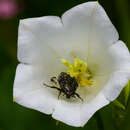en
names in breadcrumbs


Oxythyrea funesta is a phytophagous beetle species belonging to the family Cetoniidae, subfamily Cetoniinae.
Common name “White spotted rose beetle”.
This beetle is present in most of Europe, in the eastern Palearctic realm, and in the Near East.
Larvae are up to 30 mm long, they feed on plant roots and can remain until next spring in the soil.
The adults appear early in the spring, they grow up to 8–12 millimetres (0.31–0.47 in) and can mostly be encountered from May through July. They are considered an insect pest that do not just feed on pollen, but rode the floral organs, especially damaging light in color buds and flowers.
Their colour is black, more or less bronzed. Most of the specimens show six white spots in two longitudinal rows on the pronotum and many others on the elytra. They are completely covered with white pubescence (easily visible in profile). Older specimens usually have no hairs, as they are rubbed off with time.
Mating, Estonia
Oxythyrea funesta is a phytophagous beetle species belonging to the family Cetoniidae, subfamily Cetoniinae.
Common name “White spotted rose beetle”.
This beetle is present in most of Europe, in the eastern Palearctic realm, and in the Near East.
Larvae are up to 30 mm long, they feed on plant roots and can remain until next spring in the soil.
The adults appear early in the spring, they grow up to 8–12 millimetres (0.31–0.47 in) and can mostly be encountered from May through July. They are considered an insect pest that do not just feed on pollen, but rode the floral organs, especially damaging light in color buds and flowers.
Their colour is black, more or less bronzed. Most of the specimens show six white spots in two longitudinal rows on the pronotum and many others on the elytra. They are completely covered with white pubescence (easily visible in profile). Older specimens usually have no hairs, as they are rubbed off with time.